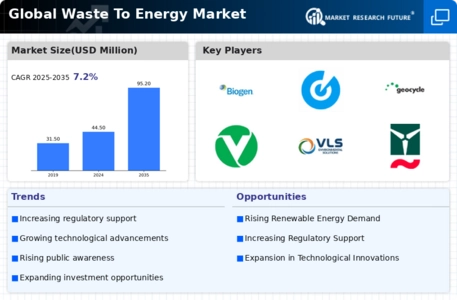Increasing Energy Demand
The Global Waste To Energy Market Industry is experiencing a surge in demand for energy, driven by the growing population and urbanization. As cities expand, the need for sustainable energy sources becomes more pressing. In 2024, the market is projected to reach 44.5 USD Million, reflecting a shift towards renewable energy solutions. Waste to energy technologies offer a dual benefit of waste management and energy production, making them attractive to governments and private sectors alike. This trend is expected to continue, as energy consumption is anticipated to rise significantly, necessitating innovative solutions to meet future energy needs.
Technological Advancements
Technological innovation is a key driver of the Global Waste To Energy Market Industry. Advances in waste processing technologies, such as anaerobic digestion and gasification, enhance the efficiency of converting waste into energy. These technologies not only improve energy output but also reduce emissions, aligning with global sustainability goals. As these technologies become more commercially viable, they attract investment and drive market growth. The anticipated compound annual growth rate of 7.15% from 2025 to 2035 indicates a robust future for the industry, as stakeholders seek to leverage these advancements for cleaner energy production.
Government Policies and Regulations
Government initiatives play a crucial role in shaping the Global Waste To Energy Market Industry. Many countries are implementing stringent regulations aimed at reducing landfill waste and promoting renewable energy sources. Policies that incentivize waste-to-energy projects, such as tax breaks or subsidies, encourage investment in this sector. For instance, various nations have set ambitious targets for waste reduction and renewable energy generation, which could lead to a market growth trajectory that reaches 95.2 USD Million by 2035. These regulatory frameworks not only facilitate the development of waste-to-energy facilities but also enhance public awareness of sustainable practices.
Economic Benefits of Waste to Energy
The economic advantages associated with the Global Waste To Energy Market Industry are becoming increasingly apparent. Waste-to-energy facilities not only generate energy but also create jobs and stimulate local economies. By converting waste into a resource, these facilities can reduce the costs associated with waste disposal while providing a renewable energy source. This dual economic benefit is particularly appealing to municipalities facing budget constraints. As the market evolves, the financial viability of waste-to-energy projects is expected to improve, attracting further investment and leading to a more sustainable economic model for waste management and energy production.
Public Awareness and Environmental Concerns
Increasing public awareness regarding environmental issues is significantly influencing the Global Waste To Energy Market Industry. As communities become more conscious of waste management and its impact on climate change, there is a growing demand for sustainable waste disposal methods. Waste to energy solutions are viewed as a viable alternative to traditional landfill practices, which are often criticized for their environmental footprint. This shift in public perception is likely to drive investments and policy support for waste-to-energy projects, further propelling market growth. The alignment of public sentiment with environmental sustainability goals is expected to foster a favorable landscape for the industry.



















Leave a Comment